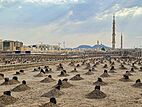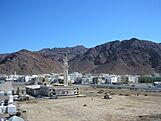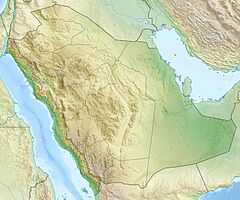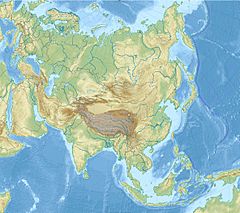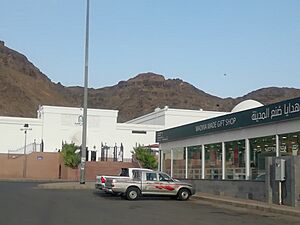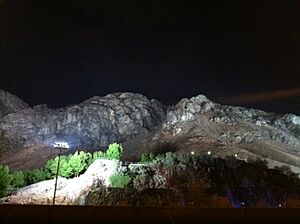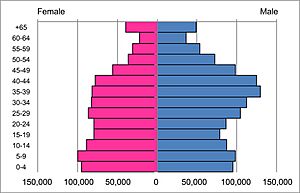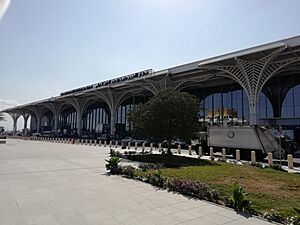Medina facts for kids
Quick facts for kids
Madinah
المدينة
|
|
|---|---|
| Al-Madinah al-Munawwarah المدينة المنورة |
|
|
|
|
| Country | |
| Province | Medina |
| First settled | 9th century BCE |
| Hijrah | 622 CE (1 AH) |
| Saudi conquest of Hejaz | 5 December 1925 |
| Named for | Muhammad |
| Districts |
|
| Government | |
| • Type | Municipality |
| • Body | Madinah Regional Municipality |
| Area | |
| • City | 589 km2 (227 sq mi) |
| • Metro | 22,900 km2 (8,800 sq mi) |
| Elevation | 620 m (2,030 ft) |
| Highest elevation
(Mount Uhud)
|
1,077 m (3,533 ft) |
| Population
(2022 census)
|
|
| • City | 1,411,599 |
| • Rank | 4th |
| • Density | 2,012/km2 (5,212/sq mi) |
| • Metro | 1,477,047 (Medina Governorate) |
| Demonym(s) | Madani مدني |
| Time zone | UTC+03:00 (SAST) |
Medina, also known as Al-Madinah al-Munawwarah, is a very important city in Saudi Arabia. It is one of the holiest cities for Muslims, second only to Mecca. In 2022, about 1.4 million people lived there, making it the fourth-largest city in the country. Medina is located in the western part of Saudi Arabia, surrounded by mountains and valleys.
This city is often called the "birthplace of Islamic culture and civilization." The Prophet's Mosque (Al-Masjid al-Nabawi) is in Medina. It is where the Prophet Muhammad is buried. He built this mosque in 622 CE. Many Muslims visit his tomb during a special trip called Ziyarat. Before Islam, the city was called Yathrib. It was later renamed Madinat an-Nabi (City of the Prophet) and then al-Madinah al-Munawwarah (The Luminous City). Today, it is simply called Madinah or Medina.
Medina has a long history. It was a city for over 1,500 years before Prophet Muhammad moved there. Under Muhammad's leadership, Medina became the capital of the growing Muslim community. It was a place where his followers, called the Sahabah, gained great influence. Medina is home to three important mosques: al-Masjid an-Nabawi, Quba Mosque, and Masjid al-Qiblatayn. The Quba Mosque is the oldest mosque in Islam. Many parts of the Quran were revealed in Medina.
Over time, Medina has been ruled by many different groups. These include Jewish-Arabian tribes, Arab tribes, and various Islamic empires like the Umayyads and Ottomans. Today, it is part of the Kingdom of Saudi Arabia. Besides visiting for religious reasons, people also visit other important places like Mount Uhud and the Al-Baqi Cemetery.
Contents
- What are Medina's Names?
- Exploring Medina's History
- Medina's Geography and Climate
- Medina's Religious Importance in Islam
- People and Culture in Medina
- Medina's Economy and Resources
- Getting Around Medina
- Images for kids
- See also
What are Medina's Names?
Yathrib: The City's Oldest Name
Before Islam, Medina was known as Yathrib. This name appears in ancient writings from the 6th century BCE. It is also mentioned in the Quran. Prophet Muhammad later asked people not to call the city by this name.
Taybah and Tabah: Names of Goodness
After a big battle, Prophet Muhammad renamed the city Taybah, which means "the Kind" or "the Good." Another similar name is Tabah. These names show the city's peaceful and blessed nature. You can hear these names in popular songs like "Ya Taybah!"
Madinah: The City of the Prophet
The city is also simply called Al-Madinah, meaning "The City." Other names include al-Madīnah an-Nabawiyyah or Madīnat un-Nabī, both meaning "City of the Prophet." It is also known as al-Madīnat ul-Munawwarah, "The Enlightened City." These names are commonly used today in official documents and on road signs.
Exploring Medina's History
Medina has many famous places, especially mosques, that are important in history. These include the three main mosques mentioned earlier. Other sites are Masjid al-Fath, the Baqi Cemetery (where many important Islamic figures are believed to be buried), and Mount Uhud. The King Fahd Glorious Qur'an Printing Complex, where most modern Qur'ans are printed, is also in Medina.
Early Settlements and Jewish Tribes
Medina has been lived in for at least 1,500 years before the Hijra (Prophet Muhammad's migration). Around the 4th century CE, Arab tribes started moving in. At that time, three main Jewish tribes lived in the city: the Banu Qaynuqa, Banu Qurayza, and Banu Nadir.
Later, two new Arab tribes, the 'Aws and the Khazraj, arrived. They first allied with the Jewish tribes. But eventually, they became independent and even fought with the Jewish tribes.
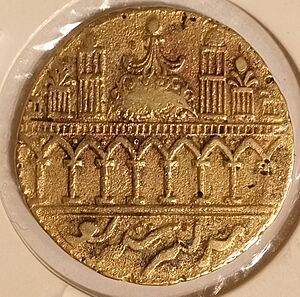
The 'Aws and Khazraj Tribes Take Control
By the end of the 5th century, the Arab tribes took control from the Jewish rulers. The 'Aws and Khazraj tribes then became enemies and fought for 120 years. Their last big battle was the Battle of Bu'ath, a few years before Prophet Muhammad arrived.
To end the fighting, some people from Yathrib secretly met with Prophet Muhammad. They invited him and his followers to their city. They hoped Muhammad could help bring peace and allow his community to practice Islam freely.
Medina Under Prophet Muhammad and Early Leaders
In 622 CE, Prophet Muhammad and about 70 followers moved from Mecca to Yathrib. This event is called the Hijrah. It completely changed the city. The long-standing conflict between the 'Aws and Khazraj tribes lessened as many people became Muslims. Muhammad was accepted as the city's leader. The local people who converted to Islam were called the Ansar (the Helpers).
All groups in the area agreed to the Constitution of Medina. This document committed everyone to work together under Muhammad's leadership. This agreement is considered one of the oldest Islamic texts.
The Battle of Uhud
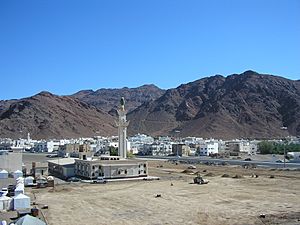
In 625 CE, a large army from Mecca, led by Abu Sufyan ibn Harb, attacked Medina. Prophet Muhammad led his army to meet them. During the battle, some Muslim archers left their positions too early. This allowed the Meccan cavalry to attack from behind.
The Muslims suffered heavy losses, and Prophet Muhammad was injured. However, the Meccans did not invade Medina and returned to Mecca.
The Battle of the Trench
In 627 CE, Abu Sufyan led another attack on Medina. To defend the city, Prophet Muhammad decided to dig a large trench around the unprotected northern side. This idea came from Salman the Persian, a Persian companion. This siege became known as the Battle of the Trench.
After a month of siege and small fights, the Meccans left because of the harsh winter. During the siege, a Jewish tribe, the Banu Qurayza, broke their agreement with the Muslims. After the Meccans left, Prophet Muhammad dealt with the Banu Qurayza. This action helped ensure the safety of the Muslim community in Medina.
For ten years after the Hijra, Medina was the main base for Prophet Muhammad and the Muslim army. Even after Prophet Muhammad conquered Mecca in 630 CE, he returned to Medina. Medina remained the most important city in Islam and the capital of the early Rashidun Caliphate.
The city was renamed Madinat al-Nabi (City of the Prophet) to honor Muhammad. Under the first three caliphs (Abu Bakr, Umar, and Uthman), Medina was the capital of a fast-growing Muslim Empire. However, when Ali, the fourth caliph, moved the capital to Kufa in Iraq, Medina's political importance decreased. It became more of a religious center.
Medina Under Later Islamic Rulers
Umayyad Caliphate (660–749 CE)
After the first four caliphs, the Umayyads took control. They took good care of Medina. They built a spring called 'Ayn az-Zarqa'a and underground water channels for farming. This helped the economy grow.
After some unrest, Medina experienced a second period of great economic growth. Trade improved, and more people moved to the city. This peaceful and prosperous time happened during the rule of Umar II.
Abbasid Caliphate (749–1254 CE)
The Abbasids also ruled Medina. During this time, there were periods of peace and political trouble. Later, the Zengids and Ayyubids took care of Medina. Leaders like Emir Nuruddin Zengi and Saladin funded improvements for pilgrims. They fixed water sources and streets. Saladin also helped protect pilgrims on their journeys.
During this period, a strong wall, 30 to 40 feet high, was built around the city. It had four gates, including the beautiful Bab al-Salam (The Gate of Peace).
Mamluk Sultanate (1254–1517 CE)
After the Abbasid Empire fell, the Mamluks of Cairo gained control of Medina. In 1258, Medina was almost destroyed by lava from a volcano, but it was saved. During Mamluk rule, the Masjid an-Nabawi caught fire twice. This period also saw more scholars living in Medina. The famous Green Dome over Prophet Muhammad's tomb was started during this time, built in 1297.
Ottoman Rule in Medina
First Ottoman Period (1517–1805 CE)
In 1517, the Ottomans took control of Medina. They continued to provide money and help to the city. In 1532, Suleiman the Magnificent built a strong fortress and castle to protect Medina. Many modern parts of the Prophet's Mosque were built during this time.
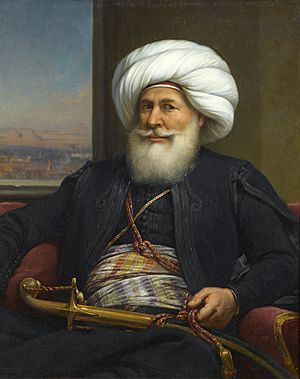
First Saudi Insurgency (1805–1811 CE)
As the Ottoman Empire weakened, the people of Medina allied with the First Saudi state in 1805. The Saudis took over the city. However, in 1811, Muhammad Ali of Egypt, an Ottoman commander, sent his army to take Medina back. After fierce fighting, his son, Ibrahim Pasha, succeeded.
Muhammad Ali's Era (1811–1840 CE)
Muhammad Ali's family governed Medina. Ibrahim Pasha renovated the city walls and the Prophet's Mosque. He also set up a center to give food and help to those in need. Medina experienced a time of peace. In 1840, Muhammad Ali handed the city back to the Ottoman Empire.
Second Ottoman Period (1840–1918 CE)

Under Sultan Abdul Hamid II, Medina saw many modern improvements. These included a radio station, a power plant for the Prophet's Mosque, and a telegraph line to Constantinople. The most famous project was the Hejaz railway, which connected Damascus to Medina. This railway helped the city's population grow quickly.
Medina in Modern Times
Sharifate of Mecca and Saudi Conquest (1918–1925 CE)
During World War I, the Sharifate of Mecca attacked Medina in 1916. The city faced a difficult three-year siege with food shortages and disease. The governor, Fakhri Pasha, refused to surrender for a long time. He secretly sent the Sacred Relics of Muhammad to Istanbul to protect them. Finally, in 1919, the city was taken by the Sharifate.
In 1924, the people of Medina secretly agreed with Ibn Saud. His son, Prince Mohammed bin Abdulaziz, conquered Medina in 1925. This led to Medina becoming part of the modern Kingdom of Saudi Arabia.
Under the Kingdom of Saudi Arabia (1925–Present)
The Kingdom of Saudi Arabia focused on expanding Medina. They also removed some old historical sites that they believed went against Islamic principles. Today, Medina is mainly important for religious reasons. Many hotels have been built around the Al-Masjid an-Nabawi. The old city walls have been replaced by three ring roads.
Medina now has an international airport, the Prince Mohammed Bin Abdulaziz International Airport. It is also connected by two major highways. The old Ottoman railway station is now a museum. A new Haramain high-speed railway connects Medina to Mecca in under 3 hours.
While the very center of the old city is only for Muslims, Medina has seen more workers and visitors from different countries. Most of the historic city has been rebuilt around the greatly expanded al-Masjid an-Nabawi.
Protecting Medina's Heritage
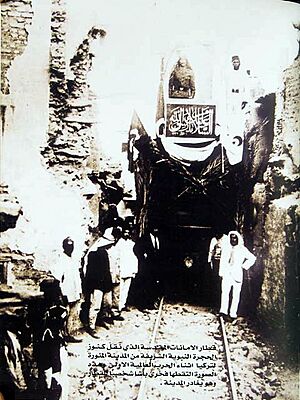
Saudi Arabia follows a strict religious view that is careful about showing too much respect to historical or religious places. This is to prevent people from worshiping anything other than God. Because of this, many old buildings and archaeological sites in Medina have been removed. Critics say that hundreds of historic sites linked to Prophet Muhammad and his family have been lost in Medina and Mecca over the last 50 years. A well-known example is the removal of tombs at al-Baqi.
Medina's Geography and Climate
Where is Medina Located?
Medina is in the Hejaz region, a strip of land between the Nafud desert and the Red Sea. It is about 720 kilometers northwest of Riyadh. The city is 250 kilometers from the Red Sea coast. It sits at an elevation of about 620 meters (2,030 feet) above sea level. Medina covers an area of about 589 square kilometers (227 square miles). It is divided into twelve districts, with seven being urban and five suburban.
Medina's High Elevation
Like many cities in the Hejaz region, Medina is very high up. It is almost three times higher than Mecca. The highest point in Medina is Mount Uhud, which is 1,077 meters (3,533 feet) tall.
Medina's Landscape
Medina is a desert oasis surrounded by the Hejaz Mountains and volcanic hills. The soil is mostly basalt. The hills, especially to the south, are made of volcanic ash. Famous mountains around Medina include Jabal Al-Hujjaj to the west, Sal'aa Mountain to the northwest, Jabal al-'Ir to the south, and Mount Uhud to the north. The city is on a flat mountain plateau where three valleys meet. This creates large green areas in the dry, mountainous region.
Medina's Climate
Medina has a hot desert climate. Summers are extremely hot and dry. Daytime temperatures average about 43°C (109°F), with nights around 29°C (84°F). Temperatures above 45°C (113°F) are common from June to September. Winters are milder, with temperatures from 8°C (46°F) at night to 25°C (77°F) during the day. There is very little rain, mostly between November and May.
| Climate data for Medina (1991–2020) | |||||||||||||
|---|---|---|---|---|---|---|---|---|---|---|---|---|---|
| Month | Jan | Feb | Mar | Apr | May | Jun | Jul | Aug | Sep | Oct | Nov | Dec | Year |
| Record high °C (°F) | 33.2 (91.8) |
36.6 (97.9) |
40.0 (104.0) |
43.0 (109.4) |
46.0 (114.8) |
48.1 (118.6) |
49.0 (120.2) |
48.5 (119.3) |
46.4 (115.5) |
43.5 (110.3) |
37.0 (98.6) |
33.0 (91.4) |
49.0 (120.2) |
| Mean daily maximum °C (°F) | 24.4 (75.9) |
27.0 (80.6) |
30.8 (87.4) |
35.5 (95.9) |
39.7 (103.5) |
43.0 (109.4) |
43.0 (109.4) |
43.8 (110.8) |
42.3 (108.1) |
37.3 (99.1) |
30.4 (86.7) |
26.0 (78.8) |
35.3 (95.5) |
| Daily mean °C (°F) | 18.3 (64.9) |
20.7 (69.3) |
24.4 (75.9) |
28.9 (84.0) |
33.3 (91.9) |
36.6 (97.9) |
36.8 (98.2) |
37.4 (99.3) |
35.9 (96.6) |
30.7 (87.3) |
24.3 (75.7) |
20.0 (68.0) |
28.9 (84.1) |
| Mean daily minimum °C (°F) | 12.1 (53.8) |
14.1 (57.4) |
17.4 (63.3) |
21.7 (71.1) |
25.9 (78.6) |
29.0 (84.2) |
29.8 (85.6) |
30.5 (86.9) |
28.6 (83.5) |
23.5 (74.3) |
18.0 (64.4) |
14.0 (57.2) |
22.1 (71.7) |
| Record low °C (°F) | 1.0 (33.8) |
1.4 (34.5) |
7.0 (44.6) |
11.5 (52.7) |
14.0 (57.2) |
21.7 (71.1) |
22.0 (71.6) |
23.0 (73.4) |
18.2 (64.8) |
11.6 (52.9) |
5.0 (41.0) |
3.0 (37.4) |
1.0 (33.8) |
| Average precipitation mm (inches) | 8.6 (0.34) |
3.0 (0.12) |
5.3 (0.21) |
6.5 (0.26) |
4.5 (0.18) |
0.2 (0.01) |
1.3 (0.05) |
3.9 (0.15) |
0.3 (0.01) |
5.2 (0.20) |
13.9 (0.55) |
7.0 (0.28) |
59.7 (2.35) |
| Average precipitation days (≥ 1.0 mm) | 0.9 | 0.3 | 0.6 | 0.9 | 0.8 | 0.1 | 0.2 | 0.6 | 0.1 | 0.8 | 1.4 | 0.8 | 7.4 |
| Average relative humidity (%) | 38 | 31 | 25 | 32 | 17 | 12 | 14 | 16 | 14 | 19 | 32 | 38 | 24 |
| Source: World Meteorological Organization, Jeddah Regional Climate Center | |||||||||||||
Medina's Religious Importance in Islam
Medina is a very important religious site because it has two mosques built by Prophet Muhammad: Masjid Quba'a and al-Masjid an-Nabawi. Islamic texts highlight Medina's sacredness. The Quran mentions Medina several times.
The Prophet's Mosque: A Sacred Place
Muslim tradition says that praying in the Prophet's Mosque is like praying 1,000 times in any other mosque. The only exception is the Masjid al-Haram in Mecca, where one prayer is worth 100,000 prayers. Prophet Muhammad built the mosque in 622 CE. It was originally an open space for prayer next to his home.
The modern Prophet's Mosque is famous for its Green Dome. This dome is directly above Prophet Muhammad's burial place. Abu Bakr and Umar, two early Muslim leaders, are also buried there. The mosque's large outdoor area is shaded by 250 special umbrellas.
Quba'a Mosque: The First Mosque in Islam
It is a good deed (Sunnah) to pray at the Quba'a Mosque. Prophet Muhammad said that whoever cleans themselves at home, then comes to Quba'a Mosque and prays there, will get a reward like performing the Umrah pilgrimage. Prophet Muhammad himself used to visit Quba'a every Saturday to pray. He built this mosque when he first arrived in Medina. The Quran also mentions Quba'a indirectly.
Medina in Islamic Prophecies
What Happens at the End of Civilization?
Some Islamic prophecies talk about the end of civilization in Medina. Prophet Muhammad said that people will eventually leave Medina, even when it is in its best state. Only wild birds and animals will remain. The last people to die there will be two shepherds.
He also said that when other lands like Yemen, Sham (Syria), and Iraq are conquered, some people will move there. But Medina would be better for them, if only they knew.
Protection from Plague and the False Messiah
Medina is believed to be protected from plagues and the ad-Dajjal (the False Messiah). Prophet Muhammad said that the terror caused by the False Messiah will not enter Medina. He also mentioned that Medina will have seven gates, with two angels guarding each gate. Another saying states that angels guard Medina's entrances, so neither plague nor the False Messiah can enter.
People and Culture in Medina
Who Lives in Medina?
In 2018, the population of Medina province was over 2.1 million people. Medina attracts Muslims from all over the world. Some visitors stay illegally after performing Hajj or Umrah, even though the government has strict rules. However, the number of illegal visitors has decreased.
Religion in Medina
Like most cities in Saudi Arabia, Islam is the main religion in Medina. Most people are Sunni Muslims. There is also a notable Shia Muslim minority. Outside the main holy area, there are many non-Muslim workers from other countries.
Medina's Diverse Culture
Medina has a mix of cultures, with people from many different countries living and interacting daily. This helps the King Fahd Complex for the Printing of the Holy Quran. This complex, established in 1985, is the world's largest publisher of the Quran. It prints books in many languages. Over 400,000 people visit it every year, and each visitor receives a free copy of the Quran.
Museums and Art in Medina
The Al-Madinah Museum shows the city's cultural and historical heritage. It has old collections, pictures, and rare images of the old city. It also includes the Hejaz Railway Museum. The Dar Al Madinah Museum, opened in 2011, focuses on Medina's architecture and city history. The Holy Qur'an Exhibition displays rare Quran manuscripts.
The Madinah Arts Center, started in 2018, focuses on modern and contemporary art. It aims to support artists and enrich the city's art scene. It holds art galleries, workshops, and discussions.
Medina also hosts an annual forum for Arabic calligraphy. This event celebrates Arabic calligraphy and famous calligraphers. The Dar al-Qalam Center for Arabic Calligraphy is now called the Prince Mohammed bin Salman Center for Arabic Calligraphy. It is an international hub for calligraphers.
Medina's Economy and Resources
How Medina Makes Money
Historically, Medina's economy relied on selling dates and other farm products. In 1920, 139 types of dates were grown there. Today, Religious tourism is a huge part of Medina's economy. As the second holiest city in Islam, it attracts over 7 million visitors each year. They come for the Hajj pilgrimage and the Umrah pilgrimage.
Medina has two industrial areas. The larger one, started in 2003, is managed by the Saudi Authority for Industrial Cities and Technology Zones (MODON). It has 236 factories that make things like petroleum products, building materials, and food. The Knowledge Economic City (KEC) is a company that develops real estate and knowledge-based industries. This project is expected to create many jobs in Medina.
Education and Learning in Medina
Schools for Children and Teens
The Ministry of Education manages schools in the al-Madinah Province. It runs many public schools for boys and girls. Taibah High School, founded in 1942, is one of Saudi Arabia's most famous schools. Many Saudi government officials have graduated from there.
Universities and Research
Taibah University is a public university that offers higher education. It has 28 colleges, with 16 in Medina. It offers 89 academic programs and had over 69,000 students in 2020. The Islamic University of Madinah, established in 1961, is the oldest higher education institution in the region. It offers degrees in Islamic studies and Arabic language. It also has engineering and computer science programs.
Al-Madinah College of Technology offers various degree programs, including electrical, mechanical, and computer sciences. Private universities in Medina include the University of Prince Mugrin and the Arab Open University.
Getting Around Medina
Air Travel
Medina is served by the Prince Mohammad bin Abdulaziz International Airport. This airport handles flights within Saudi Arabia and to other countries in the Middle East. It is the fourth-busiest airport in Saudi Arabia. In 2015, it was named the world's best airport project. It is also the first airport in the Middle East to receive a special green building certificate. The airport sees many more passengers during the Hajj season.
Roads and Walking Paths
In 2015, a project called Darb as-Sunnah (Sunnah Path) was announced. It aims to turn the 3-kilometer (1.9-mile) Quba'a Road into a pedestrian avenue. This road connects the Quba'a Mosque to the Prophet's Mosque. The project also aims to honor Prophet Muhammad, who used to walk this path every Saturday.
Medina is located at the meeting point of two major Saudi highways. Highway 15 connects Medina to Mecca in the south and to Tabuk and Jordan in the north. Highway 60 connects Medina to Yanbu, a port city on the Red Sea, and to Al Qassim in the east. The city has three ring roads: King Faisal Road, King Abdullah Road, and King Khalid Road. These roads help traffic flow around the city.
Bus and Metro Systems
Medina's bus system started in 2012. It has 10 lines that connect different parts of the city to the Prophet's Mosque and downtown. It serves about 20,000 passengers daily. In 2017, a sightseeing bus service was launched. These open-top buses take passengers to 11 destinations, including the Prophet's Mosque and Quba'a Mosque. They offer audio tours in eight languages. There are also plans to expand the bus network with 15 new lines. In 2015, a three-line metro project was announced for Medina.
Rail Travel
The old Ottoman Hejaz railway was closed after World War I. Its station in Medina is now a museum. The Haramain High Speed Railway (HHR) started operating in 2018. It connects Medina and Mecca, passing through Jeddah and other cities. This railway is 444 kilometers (276 miles) long and trains can travel at 300 km/h (186 mph). It can carry 60 million passengers each year.
Images for kids
-
Medina seen from the International Space Station in 2017. North is to the right in this image.
See also
 In Spanish: Medina para niños
In Spanish: Medina para niños




